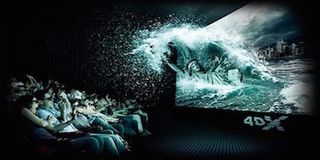My seat bucked and shook as the superheroes did battle on screen. As Batman kicked his enemy in the back, I felt a thump in my lumbar. My chair pitched backwards abruptly as the victim was sent airborne from the force of the blow.
Just moments before, we followed some characters as they traversed a frozen mountaintop; I offered my girlfriend my jacket as a frigid wind ruffled our clothes.
Though it sounds like it, this was not a sophisticated theme park attraction requiring a trip to Orlando. It’s called 4DX, and it’s poised to revolutionize the way people experience action films at their local commercial theaters across the country.
On Wednesday night, I headed over to my neighborhood Regal Cinemas near Manhattan’s Union Square to see what the buzz behind New York City’s first installation of a 4DX theater was all about. Batman v Superman: Dawn of Justice was the film selected for this format’s Big Apple debut—the company behind the technology, CJ 4DPlex, originated in South Korea and operates 228 theaters in 37 countries, with only two other locations in the U.S., in Los Angeles and Chicagoland—and although the movie had been receiving some less-than-positive reviews, it seemed like a great choice for the action alone.

Arriving right before the scheduled screening time, as 4DX tickets have assigned seating, I found my seat among sets of four connected chairs, each quite bulky and spacious with large, LED-illuminated footrests. In front of the seats, a padded rail resembling a disengaged rollercoaster lap bar harbored small nozzles, aimed to squirt drops of water at the viewer. Along the top of the sidewalls hung large, cylindrical fans directed at varying angles at the seats below. (We were afforded extra time to observe our surroundings, as technical difficulties delayed the start of the showing).
After the issues were resolved, the experience began immediately—no coming attractions—with a quick demonstration of the technology in the form a car-chase scene that played first like a normal 3D movie, then again with the 4DX seats, fans, and other mechanisms enabled. Giddy moviegoers around the theater reacted collectively with awe and amusement as the extent of the experience they were about to encounter was made clear.
The first few minutes of the film offered a decent summary of how the presentation would pan out. There were moments that were undoubtedly heightened by the additional sensory activation—such as vibrations from Bruce Wayne’s parents’ assassin’s gun, and the wind and sudden dropping effect when as the newly orphaned Wayne falls into a pit while running through the woods. In other scenes, however, the extra frills were an unwelcome distraction that pulled me out of the onscreen events, such as unnecessary chair movements in non-action scenes, or seat movements tied to the motion of crane-mounted cameras instead of the action that they were capturing.
In fairness, the film was not planned with 4DX technology in mind (although future films are reportedly in development that are), so some kinks were to be expected. Nevertheless, there were detractions caused by the technology that could be tweaked for a superior experience. Strobe lights at the top of either sidewall, which are activated in conjunction with onscreen lightning or other lighting effects, ended up illuminating the red-yellow-and-purple pattern of the theater’s wall covering, creating an effect similar to the DLP “rainbow” in the periphery of my vision at each firing. And air jets hidden in the seat’s headrest that discharge with a loud “pffft” to simulate events like bullets flying from behind the viewer did more to disturb than envelop.
Overall, though, there’s no denying that this was a fun, unique experience that could easily gain widespread adoption, especially with the introduction of films specifically created for the format (I just discovered, much to my disappointment, that the upcoming first-person action film Hardcore Henrywon’t be among them). And for a ticket price of $30, it sure beats the expense of visiting a theme park—and waiting in line for 45-plus minutes for a five-minute show. Keep a lookout as this technology expands to a theater near you.




